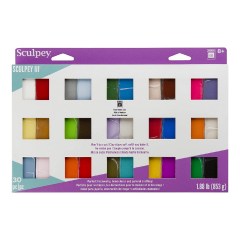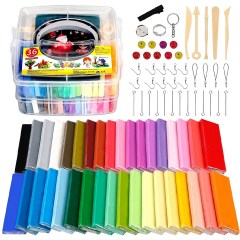BestReviews is reader-supported and may earn an affiliate commission. Details

This clay is soft and easy to mold while you're working and keeps its form once you bake it in the oven.
This set features a wide range of 1 oz. color bars for many creative possibilities. The non-toxic polymer clay is safe for all ages. A great bargain set for beginners and children. It keeps its softness when stored correctly.
There's not very much of every color.

This 36-color set comes with 5 tools, an accessory pack, a storage box, and a helpful project booklet for beginners.
There's a wide range of colors for all uses. Great for novice sculptors of all ages. The colors work together, blend, and don't dry out until you cure it. The bright colors are perfect for modeling characters, fake food, and general crafting.
Not ideal for experienced artists. Small amount of every color.

32 colors, from natural browns and olive greens to vibrant pinks and flesh tones.
The wide-ranging color tones go beyond neon color schemes and give you more natural options. This clay is great for miniature creations. It's non-toxic and safe for all ages. A good, safe set for experimental artists and beginners alike.
No storage included. The clay is more difficult to knead than many.

Sargent is among the most trusted names in art, and this block of beige clay is perfect for your next creation.
This single-color block has a neutral color that's easy to paint over. Great for sculptures and painting/crafting new creations. It's non-toxic, odorless, and only sticks where you want it to stick. Great for artists and sculptors.
Just one color - but there's other options on the market.

This comprehensive set has 50 colors and a variety of clay tools with endless possibilities.
Use an oven, hair-dryer, or boiling method to cure your favorite creations. There's a wide range of clay tools to play around with - from keychains to detail styluses. The plastic box means you don't need to find extra storage space.
Small blocks don't go far.

We recommend these products based on an intensive research process that's designed to cut through the noise and find the top products in this space. Guided by experts, we spend hours looking into the factors that matter, to bring you these selections.

Polymer clay is a popular choice for both beginning and experienced artists due to its highly malleable texture and its strength once dry. This plastic-based material comes in a wide range of colors, and the colors can be mixed for an expanded palette. The clay contains no oil or water, so it will last for weeks or longer without drying out if properly stored.
Whether you want to make jewelry or you’re looking for an easy kids’ craft material, polymer clay is an approachable and forgiving medium. However, there are some considerations to keep in mind while shopping. Each brand of polymer clay has a unique texture and softness. And while some types are inexpensive, the cheaper brands can be more difficult to work with. A good buying guide and recommendations can help you find the right polymer clay for your next craft project.

Polymer clay is a common material used by anyone new to sculpting or working with clay in general. However, it is used by artists of all skill levels, so there are different varieties for amateur and professional use.
Polymer clay isn’t actually clay and doesn’t contain any clay. It’s a polyvinyl chloride (PVC)-based mixture called plastisol. Essentially, it’s plastic particles with an added component (usually a plasticizer) that makes it pliable. Polymer clay has evolved over the years as manufacturers use different ingredients to ensure customer safety.
To cure, or harden, polymer clay, it must be placed in an oven or toaster oven and heated to about 275°F, though the temperature varies from one brand to another. The amount and thickness of the piece determine the length of time it needs to bake.
Most types of polymer clay will age over a long period of time and become hard and brittle even when kept in the original packaging.
Each type of clay has its applications and, with the exception of pottery clay, all are suitable for beginners with the right project in mind. Polymer clay offers a good balance between ease of sculpting and long-term durability.
Polymer clay is one of the most popular sculpting media because of its ability to remain workable for long periods without drying out. It is inexpensive in small amounts, and it’s highly durable once cured. You can safely leave the cured piece unsealed, or you can glaze or paint it. However, it isn’t the right material for every project.
Water-based clay, also called “natural” clay, is a mixture of clay and water. It is soft and easy to work with and doesn’t require a kiln to set. Sculptures can be smoothed easily, but finished pieces are quite brittle and prone to cracking. Additionally, silica dust can linger in the air and on surfaces and can be harmful if inhaled.
Oil-based clay is soft and easy to work with, though you’ll need to use a solvent to smooth the surface of your sculptures. This clay is well suited to highly detailed projects, but the finished pieces can’t be handled like baked polymer clay sculptures. It doesn’t age or dry out, so it can be kept on the shelf for years. Oil-based clay can’t be fired, but the sculptures will last for a long time if left undisturbed. Because they don’t dry out, you can recycle old sculptures to make new ones, but they can collect dust and can be damaged by sunlight.
Pottery clay comes in a few different types, all of which are often used on a pottery wheel to create smooth, symmetrical bowls, vases, and other shapes. This type of clay is challenging to work with, and it must be fired in a kiln to create a finished product. Opt for pottery clay if your goal is to create long-lasting vases, bowls, and other pieces on a pottery wheel.

As with colored pencils or oil pastels, polymer clay varies significantly from one brand to the next. More expensive clay tends to last longer and be easier to work with, but the specific qualities and colors differ between brands.
Polymer clay comes in a huge range of colors, even in inexpensive beginner sets. However, before you buy an 80-color set, consider that you aren’t likely to use all or even most of the colors and will therefore have a limited quantity of clay to work with.
Generally speaking, the fewer colors you have, the more of your clay you’ll use. And because you can blend polymer clay to create new colors, you aren’t limited to the colors that come in a pack.
Depending on your project, you might need soft or firm polymer clay. Brands differ in their pliability, and while many brands make claims about the softness or firmness of their clay, it’s hard to tell without holding it in your hands. If you can’t feel it, the best way to determine a clay’s softness is to read user reviews.
Soft clay is good for children because their hands are small and not very strong. You can use this clay to quickly make small sculptures, and if detail isn’t a priority, you can make larger sculptures faster than you can with a firm clay.
Firm clay is preferred if you need to make detailed shapes and lines or want a sculpture to hold its shape over a long period.
You can save money by recycling old sculptures to make new ones rather than starting with fresh clay.
The cost of polymer clay depends on the amount and quality of clay and the number of colors included.
You can buy a few sticks of clay in one color or a few colors for $3 to $8. If you’re just starting out, this range offers an accessible entry point. Additionally, if you need a particular color but don’t want to buy a whole set, packs in this range are an inexpensive solution.
Polymer clay packs that cost $8 to $15 can include dozens of sticks in different colors or be smaller packs of high-quality clay from popular brands.
The most expensive polymer clay packs cost from $15 to $30 for a dozen sticks. Bulk packs of 20 pounds or more can cost as much as $150.

You can start shaping and molding polymer clay right out of the package, but proper conditioning and baking are essential for a high-quality result.
1. Conditioning: This is the process of working the clay with your hands or running it through a pasta machine to remove any bubbles. If you don’t condition your clay, it will be brittle and prone to cracking and breaking.
2. Softening or firming: If your clay isn’t the right consistency, you need to soften or firm it as needed. To soften clay, you can simply condition it further, or you can add another element like mineral oil or even a softer clay until it reaches the right consistency. To firm polymer clay, you can leach it by putting it between two sheets of paper and placing a heavy object on top. The clay should be significantly softer after a few hours.
3. Sculpting: You’re finally ready to get to work. Whether you’re creating a large figurine or small piece of jewelry, make sure you have the right tools for the job.
4. Curing: This step varies from one brand to the next, so you should refer to the packaging for the appropriate temperature and length of time. The thicker your piece, the more baking time it will need.
5. Sanding and finishing: Using a slightly damp piece of sandpaper, gently rub the surface of the clay in a circular motion. Gradually work your way from coarse (low grit) to fine (high grit) sandpaper. When your piece is done, rinse it to remove any dust. This step is optional, but it produces a consistently smooth finish.
6. Painting and glazing: Slightly watered down acrylic paint works best on polymer clay. Wipe away excess paint with a paper towel as you work. For best results, use glazes and varnishes specifically designed for use on polymer clay.

A. You can, but you can’t eat or drink out of them because they aren’t food safe. It’s best to avoid making anything resembling a dish or vessel to make sure that no one uses it with food.
A. Aside from dinnerware, there are few restrictions on what you can sculpt out of polymer clay. Jewelry is a popular option since the material is strong enough to be made into beads. With the wide variety of colors, characters are a popular choice among children. You can also make fridge magnets, dollhouse decorations, or two-dimensional scenes.
A. Choose the colors you want to combine and note the quantity of each in case you want to make more of the final color. Press layers of each color together and roll them with a rolling pin or put them through a pasta maker repeatedly until the colors are fully blended.
Get emails you’ll love.
Learn about the products you’re wondering if you should buy and get advice on using your latest purchases.
BestReviews wants to be better. Please take our 3-minute survey,
and give us feedback about your visit today.
